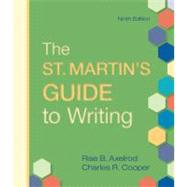The best-selling college rhetoric for nearly 25 years, The St. Martin’s Guide has achieved an unparalleled record of success by providing practical innovations for the ever-changing composition course. Comprehensive yet flexible, The Guide’s acclaimed step by step guides to each type of writing offer sure fire invention strategies to get students started, combined with thorough advice on critical reading, working with sources, and careful revision.
Axelrod and Cooper’s class tested guidance on visual rhetoric, online teaching and learning, and more is available for instructors who incorporate these topics into their courses but not intrusive, for those who don’t.
The new edition has been re-engineered to reflect and build on the actual writing processes of students and does even more to prepare them for the writing they will do in other college courses.








